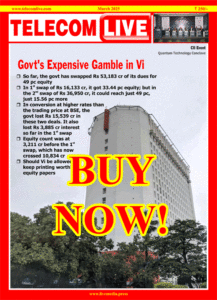5G to improve rural healthcare delivery, says NHA chief
Fifth-generation or 5G technology will benefit the healthcare services in rural India following the improved connectivity and high data throughput, and also boost the Centre’s ambitious National Digital Health Mission (NDHM), a top official said.
“Rural India will be benefited with 5G through increased connectivity and high throughput of data,” National Health Authority (NHA) chief executive Ram Sewak Sharma said and added the next-generation of technology in healthcare would be useful in areas like telemedicine.
5G, touted as a next-generation technology with low-latency communications, is expected to offer multiple use cases across business sectors including healthcare.
“The new technology will actually improve connectivity such as Wi-Fi and fixed wireless access (FWA) for better delivery of medical care and remote surgery. It will also play a critical role in the National Digital Health Mission (NDHM),” Sharma said.
Launched on August 15, 2020, by Prime Minister Narendra Modi, the national mission, under the NHA, seeks to provide medical identity to enable Indians to access the prestigious Ayushman Bharat Yojana, a public-funded healthcare service.
PricewaterhouseCoopers or PwC, a London-based professional services firm said that the use of 5G in healthcare would develop a new health ecosystem and give a rise to applications on the back of advances in robotics, artificial intelligence and Internet of Things (IoT) for predictive, preventative, personalised and participatory medicine.
Sharma who also had a five-year-long stint at the Telecom Regulatory Authority of India (Trai), said that one of his key objectives is to ensure seamless healthcare services using technology-driven platforms.
The Department of Telecommunications (DoT) is though yet to come up with a roadmap for 5G field trials to showcase India-specific use cases while the auction for airwaves is deferred to a year following the unavailability of sufficient quantum of spectrum and increased industry pressure to lower the pricing.
Indian telecom carriers such as Reliance Jio, Bharti Airtel, and Vodafone Idea see healthcare services as one of the few potential business use cases for the next-generation networks.
In 2018, Trai had recommended 3300 megahertz – 3600 megahertz frequency band for the commercial launch of next-generation services, after it was earmarked for International Mobile Telecommunications (IMT) applications.
However, the Indian Navy is using 100 megahertz of spectrum for radar operations and the Indian Space Research Organisation (ISRO) had set up space hubs for the GPS navigation system using 25 megahertz leaving only 175 megahertz radio waves in the 3300-3600 megahertz band for telecom services.
The telecom service providers have been demanding adequate volume of the spectrum and also sought millimeter-wave (MMWave) band for the rollout of high-speed data services.



